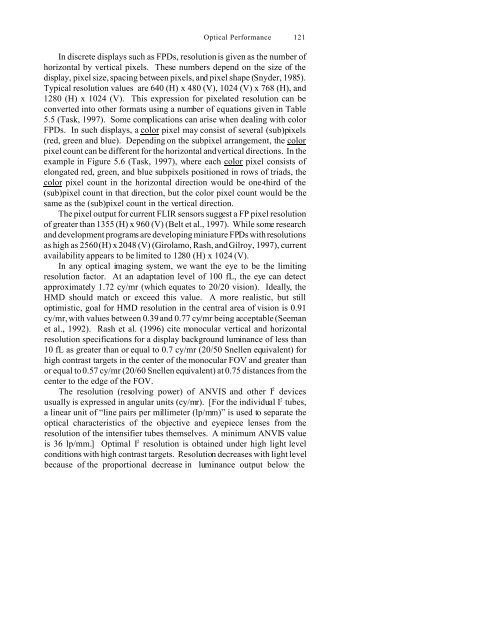Helmet-Mounted Displays: - USAARL - The - U.S. Army
Helmet-Mounted Displays: - USAARL - The - U.S. Army
Helmet-Mounted Displays: - USAARL - The - U.S. Army
Create successful ePaper yourself
Turn your PDF publications into a flip-book with our unique Google optimized e-Paper software.
Optical Performance 121<br />
In discrete displays such as FPDs, resolution is given as the number of<br />
horizontal by vertical pixels. <strong>The</strong>se numbers depend on the size of the<br />
display, pixel size, spacing between pixels, and pixel shape (Snyder, 1985).<br />
Typical resolution values are 640 (H) x 480 (V), 1024 (V) x 768 (H), and<br />
1280 (H) x 1024 (V). This expression for pixelated resolution can be<br />
converted into other formats using a number of equations given in Table<br />
5.5 (Task, 1997). Some complications can arise when dealing with color<br />
FPDs. In such displays, a color pixel may consist of several (sub)pixels<br />
(red, green and blue). Depending on the subpixel arrangement, the color<br />
pixel count can be different for the horizontal and vertical directions. In the<br />
example in Figure 5.6 (Task, 1997), where each color pixel consists of<br />
elongated red, green, and blue subpixels positioned in rows of triads, the<br />
color pixel count in the horizontal direction would be one-third of the<br />
(sub)pixel count in that direction, but the color pixel count would be the<br />
same as the (sub)pixel count in the vertical direction.<br />
<strong>The</strong> pixel output for current FLIR sensors suggest a FP pixel resolution<br />
of greater than 1355 (H) x 960 (V) (Belt et al., 1997). While some research<br />
and development programs are developing miniature FPDs with resolutions<br />
as high as 2560 (H) x 2048 (V) (Girolamo, Rash, and Gilroy, 1997), current<br />
availability appears to be limited to 1280 (H) x 1024 (V).<br />
In any optical imaging system, we want the eye to be the limiting<br />
resolution factor. At an adaptation level of 100 fL, the eye can detect<br />
approximately 1.72 cy/mr (which equates to 20/20 vision). Ideally, the<br />
HMD should match or exceed this value. A more realistic, but still<br />
optimistic, goal for HMD resolution in the central area of vision is 0.91<br />
cy/mr, with values between 0.39 and 0.77 cy/mr being acceptable (Seeman<br />
et al., 1992). Rash et al. (1996) cite monocular vertical and horizontal<br />
resolution specifications for a display background luminance of less than<br />
10 fL as greater than or equal to 0.7 cy/mr (20/50 Snellen equivalent) for<br />
high contrast targets in the center of the monocular FOV and greater than<br />
or equal to 0.57 cy/mr (20/60 Snellen equivalent) at 0.75 distances from the<br />
center to the edge of the FOV.<br />
<strong>The</strong> resolution (resolving power) of ANVIS and other I 2 devices<br />
usually is expressed in angular units (cy/mr). [For the individual I 2 tubes,<br />
a linear unit of “line pairs per millimeter (lp/mm)” is used to separate the<br />
optical characteristics of the objective and eyepiece lenses from the<br />
resolution of the intensifier tubes themselves. A minimum ANVIS value<br />
is 36 lp/mm.] Optimal I 2 resolution is obtained under high light level<br />
conditions with high contrast targets. Resolution decreases with light level<br />
because of the proportional decrease in luminance output below the






